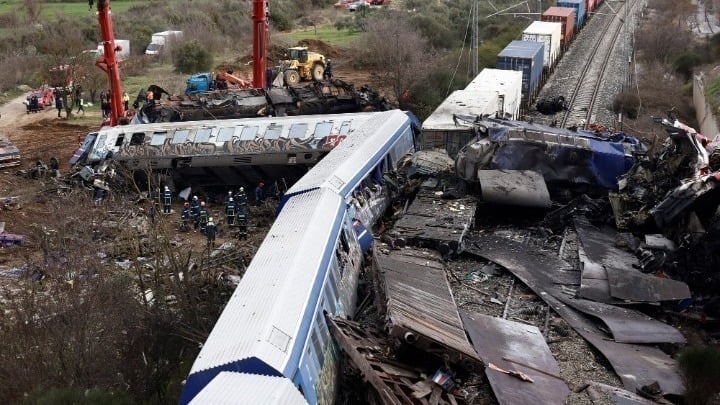
The railway disaster at Tempe is in Greek headlines again on the one-year anniversary of the tragic collision that took the lives of 57 people, most of them young.
Costas Lakafossis, an aeronautical engineer and accident expert, spoke to Greek Reporter about the railway disaster, pointing out omissions and mistakes during the official investigation.
The investigation is ongoing amidst bitterness and suspicion on the part of the families affected. The tears of those who lost their loved ones have dried, but the anger remains, still palpable. It has been one year and not one official has taken responsibility for the accident. Not one apology has been uttered by official lips, whether from the State or Hellenic Train.
There are accusations of a systematic cover-up. An official Tempe victim association has begun collecting signatures for a petition against the government. It is for the lifting of parliamentary immunity of representatives who are potentially responsible for the Tempe tragedy. So far, 780,000 thousand people have signed, demanding justice.
A Greek parliament investigating committee has not produced any valuable results on why so many people were killed and who is responsible. Opposition party representatives have walked out of the committee placing the blame on the government, speaking of the “Tempe crime.” So far, 32 people have been charged while several more might follow.
Why was the accident scene covered after the collision?
There was an unexplained hastiness to cover the scene of the railway disaster. This was despite the fact that the investigation was still in motion and relatives of the victims were still looking for the belongings of their loved ones. Consequently, this led to questions about what the cargo train was carrying and if its content was documented.
“The train had a legally declared cargo with official documents which were subsequently confirmed as to their accuracy,” Lakafossis told Greek Reporter.
“Nevertheless, behind the two electric engines, the first three carriages were flat open platforms loaded with large metal sheets” Lakafossis said. “There is no way to determine if there was any undeclared cargo on top of them since the videos from security cameras at the loading station and the station of Thessaloniki up to the Neoi Poroi station have been erased. The official investigators delayed asking for the video footage and OSE (Hellenic Train) claimed that the camera footage has been erased so that the digital discs can be used again.”
“The chemical samplings from the wreckage of the wagons and from the point of collision were made 29 days late on March 29th, while they should have been done within the first two or three days and certainly before the removal of debris from the site,” Lakafossis continued.
“As for research on the deflagration and the fire that followed, the time delay was a bigger problem than the alteration of the collision site itself,” he said.
“This was caused by the rush to remove the debris and alter the site. There were human remains among the debris and one family was not given the chance to bury the remains of their loved ones.
“Other families had to carry the extra psychological burden from the sad process of finding residuals of their loved ones on May 31 and then on November 15 and 16 (when the accident site was re-opened for search),” Lakafossis revealed. “This should have been done with care in the first few days.”
Were the findings assessed properly?
The families of the victims of the railway disaster have questioned whether the official investigation was conducted properly and the findings were properly assessed. To that, the accident expert told Greek Reporter:
“As for assessing the facts and the reasons that led to the collision, the official investigation is sufficient and complete,” Lakafossis said. “But in regards to questions about the explosion and the fire—now that it is proven that the fire took the lives of at least five of the victims—there is an obvious blank. Sufficient explanations of the deflagration causes have not been given.”
“If we accept that this phenomenon (fire ignition) was normal and expected, then the question arises as to whether measures had been taken to prevent such a dangerous fire ignition when there are many electric engines circulating in Greece’s railway network,” he added.
Lakafossis also commented on the overall lack of safety measures of the railway transportation system:
“We, as aviation investigators, found that the State investigation shows a lack of actions taken to improve the safety of railway transportation, a process that requires root cause analysis and thorough research into human factor issues, in order to identify the real causes (of the railway disaster), out of the narrow legal framework of the issue.”
It was February 28, 2023 when a passenger train left Athens with Thessaloniki as its destination. Many of the passengers were students returning from the Patras Carnival.
A few minutes before midnight, their train collided with a cargo train headed to Athens. Τhe collision caused a combustion, covering the first wagon in flames. There were 57 dead—five of them incinerated—and 85 injured.
See all the latest news from Greece and the world at Greekreporter.com. Contact our newsroom to report an update or send your story, photos and videos. Follow GR on Google News and subscribe here to our daily email!



